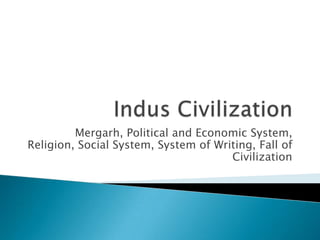
Indus civilization
- 1. Indus Civilization Mergarh, Political and Economic System, Religion, Social System, System of Writing, Fall of Civilization
- 2. Fertile land along the rivers of Indus, Ganges and Brahmaputra in the north Dry Deccan Plateau in central India Low mountain ranges called the Western and Eastern Ghats on the either side of India facing the seas 3 Divisions of South Asia
- 3. Melting snow from Himalayas Heavy rains Silt deposit is left along the riverbanks after every flooding. The deposits make the land fertile and suitable for agriculture Water source of Ganges, Indus and Brahmaputra
- 4. Pre-Indus Neolithic village Appeared in Baluchistan region (now Pakistan) Sedentary (sitting or nonmigratory) Engaged in agriculture and raised sheep, goats and oxen Painted pottery, baked bread and made cereal Their houses were made of clay bricks like the Sumerians Mergarh
- 5. Archaeologists(1922) discovered the remains of one of the cities in the Indus River Monumental buildings Houses made of bricks Clay seals Political and Economic Systems
- 8. Two most important cities of the Indus civilization (Dravidians) Economic Activities Agriculture Built irrigation systems, canals and dikes to control flooding of the Indus River Products: wheat, barley, melon, dates and cotton Mohenjo-Daro and Harappa
- 9. Economic Activities Cotton was woven into cloth Pottery, jewelry and tools Sold in government bazaars Carried by Dravidian ships, traded with the regions in the Arabian Sea and Persian Gulf Continuation
- 10. 2 main areas: Citadel(the elevated fortress of the city) Lower city proper City
- 11. Found in the western region of the city, erected on the brick platform with a height or 40 feet or 12 meters and is surrounded by walls Inside, will find a large granary for grains, a marketplace and public bath Citadel
- 13. Has streets in a grid-pattern arrangement and with residential blocks of almost the same size Houses are made of baked bricks The roof is flat and often constructed against the street. Houses have one or more baths which is connected to the city’s underground plumbing system Lower part of the City
- 15. Has streets in a grid-pattern arrangement and with residential blocks of almost the same size Houses are made of baked bricks The roof is flat and often constructed against the street. Houses have one or more baths which is connected to the city’s underground plumbing system
- 16. Mohenjo-Daro
- 17. Excavated toys that indicates leisure and play No weapons found imply absence of war and conflict Dravidians have organized and centralized government Dravidians had priest-kings as leaders They were able to construct public works (irrigation, plumbing system and regular residential blocks) Other facts
- 19. Dravidians worshipped gods and goddesses who represented forces of nature. Animal and human-shaped statues were found. Ex. Bull They worshiped a fertility goddess from whom all things sprung forth Regilion
- 20. Social Stratification Those who lived in the citadels may have been members of the ruling class – priest-king and city officials The traders, artisans and farmers lived outside the citadel Farmers were tasked to build the dikes and canals for irrigations while the artisans made products out of bronze, silver, gold, copper, ivory, cotton and shells Social System
- 21. Scholars believed that the traders were the first to use the Indus system of writing. Clay seals with pictograms of products Evidence that there exist a trade between Sumer and Indus System of Writing
- 22. Dravidian traders and engineers had developed a uniform way of measuring and weighing things. This is very evident in their same-sized residential blocks and grid-patterned streets. Continuation
- 23. After 1000 years of prosperity, Indus civilization slowly decayed. Around 1750BCE, there was a decline in their quality of life. Pottery became courser in their texture before Fall of Civilization
- 24. Caused by ecological factors such as deforestation, changes in flood occurrences and abrupt change in climate New migrants came to the Indus valley in the later period Nomadic groups from Northwestern Asia arrived sometime 1500 BCE Among them were the Aryans who crossed the passes of Hindu Kush but not clearly whether they destroyed the Indus civilization Theories of the Fall
- 25. The cities of Mohenjo-Daro and Harappa were slowly buried in mud. Their legacy was recently excavated by archaeologists. Continuation